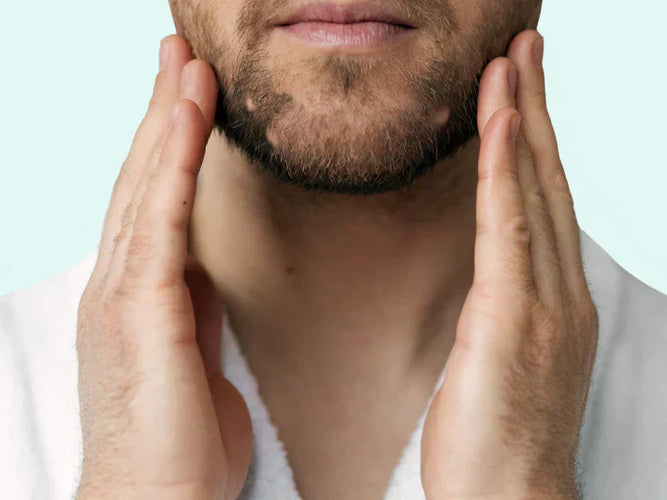Alopecia barbae is a type of hair loss that affects the beard area. It causes round, smooth bald patches that can feel soft, like peach skin. While alopecia barbae is not contagious and can appear without other hair loss problems, it often affects a man’s appearance and confidence.
There is no cure for alopecia barbae, but once the hair starts to grow back naturally, you can support beard regrowth with the right care. In this article, you’ll learn what alopecia barbae is, what causes it, how to recognise it, and how to support your beard once recovery begins.

View our Beard Growth Products
What does alopecia barbae do to your beard?
Alopecia barbae is a form of alopecia areata that attacks the hair follicles in the beard. It’s an autoimmune condition where the immune system wrongly targets healthy hair follicles. This leads to patchy beard hair loss, often seen on the jawline, chin or cheeks.
Some men develop just one or two patches, while others may lose hair on larger parts of the face or even other parts of the body. It most often begins around the age of 30.
How can you recognise alopecia barbae?
The first signs of alopecia barbae are small, round bald spots in the beard. These patches are usually the size of a coin and feel smooth. They often appear along the jawline, chin or cheeks. As more hair falls out, the patches may grow or join together.
Sometimes the hair around the bald area looks white, and short broken hairs, known as “exclamation mark hairs”, may be seen at the edges. The skin can feel itchy or sore before hair falls out. In some cases, the bald areas may look red, irritated or slightly inflamed.
In many cases, new hair begins to grow back after a few months. These first hairs are often thin or white, and can darken and thicken over time.

Infographic: Alopecia barbae explained
How common is alopecia barbae in men?
Alopecia barbae is not very common. The lifetime risk of developing alopecia barbae is about 2%. This means that only a small number of men will experience bald patches in the beard from this condition at some point in their life.
What causes alopecia barbae?
Alopecia barbae is caused by the immune system attacking the beard follicles. Genetics plays a big role: it’s more likely to occur if someone in your family has alopecia, asthma or allergies. The risk is also higher if you or your relatives have other autoimmune diseases, such as type 1 diabetes, lupus or psoriasis.
Stress may be a trigger in some cases, for example after illness or emotional pressure. However, in many people, alopecia barbae starts without any clear reason.
It’s important to know that hormones like testosterone or DHT are not responsible. Alopecia barbae is not caused by a hormone imbalance.
What does recovery look like?
In many men, alopecia barbae improves on its own within several months to a year. About half of the men see regrowth in the first year. Hair usually comes back as fine or white hairs at first, which can return to their normal colour and thickness later.
Recovery depends on different factors. If hair loss is limited to a few small patches, the chance of full regrowth is usually good. If there are many bald spots or if they cover a large area, regrowth may take longer or be incomplete. Factors such as young age at onset, nail changes, family history or autoimmune conditions can affect recovery.
Alopecia barbae can come and go. New patches may appear again, even after earlier recovery. If the bald spots spread quickly, last long or cause concern, it’s a good idea to see a doctor. Emotional support can also help if the condition affects your confidence.
How can you support beard growth after recovery?
Neofollics has developed a product line to support beard growth during and after the recovery phase. In image 1, the man has used the Neofollics Beard Growth Stimulating Serum and Neofollics Beard Growth Supporting Tablets for 3 months. His beard line has become fuller, and his beard hairs have clearly grown.

Image 1
The serum contains clinically and dermatologically tested ingredients that help reactivate recovering follicles. For even better results, use the serum with a derma roller, which stimulates the skin with tiny needles. This improves blood flow and helps the serum reach the hair follicles more effectively.
Neofollics products are designed for men who want to support their beard growth naturally after alopecia barbae. Results vary per person. Consistent use over a longer period is recommended.
Dealing with emotional impact
For many men, a beard is part of their identity and appearance. That’s why beard bald spots can lead to frustration, insecurity or lower self-esteem.
Be kind to yourself and remember that alopecia barbae is common and often temporary. If you struggle with confidence, talk to your doctor or seek support from a psychologist. You’re not alone and support is available.
Conclusion
Alopecia barbae is a type of hair loss that causes bald patches in facial hair due to an immune system reaction. Many men recover within a year, and although there’s no cure, you can support natural regrowth with the right care.
Neofollics offers a beard care routine to help support your beard as it grows back. If you have concerns or questions, don’t hesitate to speak to a medical professional.
Sources
Aamir, M., Khan, A., Nawaz, M. F., et al. (2023). Alopecia areata: an updated review of pathogenesis, diagnosis, and management. Cureus, 15(5), e39518.
Messenger, A. G., & McKillop, J. (2022). Alopecia areata: current understanding of aetiology and management. The Lancet, 399(10341), 2110–2120.
Alkhalifah, A., Alsantali, A., Wang, E., McElwee, K. J., & Shapiro, J. (2022). Alopecia areata update: Part I. Clinical picture, histopathology, and pathogenesis. Journal of the American Academy of Dermatology, 86(3), 483–495.
This information does not replace professional medical advice. If in doubt, always consult a doctor or specialist.













